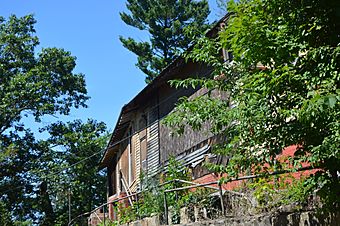Switchback School facts for kids
|
Switchback School
|
|

Western side of the school
|
|
| Location | 210 Pinehurst Heights Rd., near Hot Springs, Virginia |
|---|---|
| Area | 0.9 acres (0.36 ha) |
| Built | 1924-1925, 1933, c. 1960 |
| Architect | Rosenwald Fund |
| MPS | Rosenwald Schools in Virginia MPS |
| NRHP reference No. | 13000985 |
Quick facts for kids Significant dates |
|
| Added to NRHP | December 24, 2013 |
Switchback School, also known as Union Hurst School, is a special historic building near Hot Springs, Virginia. It is located in Bath County, Virginia. This school is a type of building called a Rosenwald school. These schools were built a long time ago to help African-American students get a good education.
The school was built between 1924 and 1925. It is a one-story building made of wood. It was designed to have two teachers. The outside of the school is covered with wooden boards, and its roof slopes down on two sides.
Contents
The School's History
The Switchback School was first built almost 100 years ago. It was a very important place for learning. In 1933, a large part was added to the south side of the building. Later, around 1960, another section was added. This shows how the school grew over time.
Other Buildings and Features
The school property has other interesting parts too. There is an old outhouse from around 1950. An outhouse is a small building used as a toilet. There is also a cistern, which is a tank for collecting rainwater. This cistern was built in the late 1930s by workers from the Civilian Conservation Corps. This was a government program that helped people find jobs during a tough economic time.
Also, three stone walls were built around the same time by workers from the Works Progress Administration. This was another government program that created jobs. These additions show how the community helped improve the school grounds.
What is a Rosenwald School?
Rosenwald schools were built with money from Julius Rosenwald. He was the head of Sears, Roebuck and Company. He worked with Booker T. Washington to build schools for African-American children in the Southern United States. At that time, many schools for African-American students did not have good buildings or supplies.
These schools were very important because they gave many students a chance to learn. In Virginia, 364 Rosenwald schools were built. Today, only about 70 of them are still standing. Switchback School is one of these important surviving schools.
A Historic Landmark
Because of its history and importance, Switchback School was added to the National Register of Historic Places in 2013. This means it is recognized as a special place that should be protected. It helps us remember an important part of American history and the efforts made to provide education for all children.



